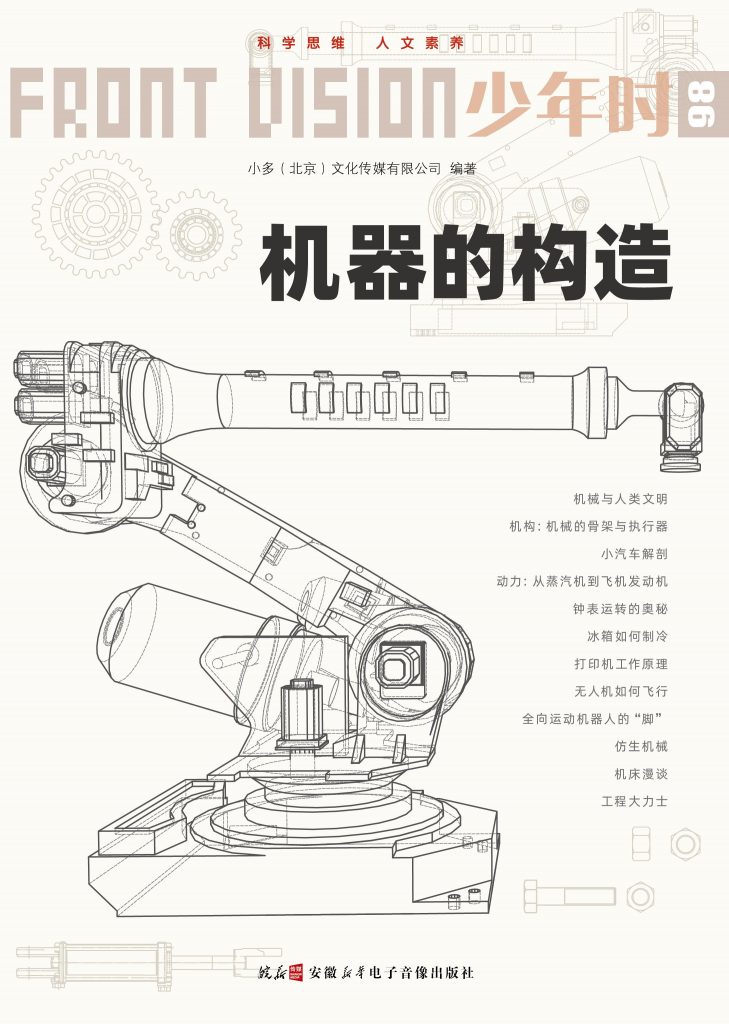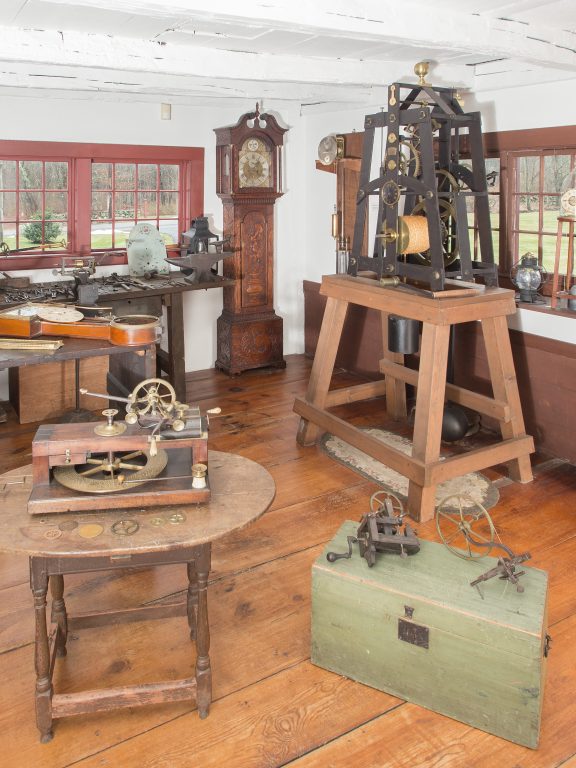Image: Willard House & Clock Museum
This article appears in the January 2023 issue of Front Vision, an educational Chinese-language magazine for kids. It is reproduced here with permission. Many thanks to the Willard House & Clock Museum for sharing their expertise!
What Makes a Timekeeper Tick?
by Kathryn Hulick
Tick Tock. Tick Tock. The sounds of clocks and timepieces surround me. I’m standing inside the Willard House & Clock Museum in North Grafton, Massachusetts.
In my everyday life, when I need to check the time, I glance at my phone or my laptop or the car dashboard. All of these displays use electronics and batteries to track time. Mechanical clocks are different. They’ve existed for almost eight hundred years while electronics have been around for less than two hundred years. Those ticks and tocks hint at what’s happening behind the dials. They are keeping track of time mechanically. How does that even work? That’s what I’m here to find out.
My guide is Robert C. Cheney, executive director and curator of the museum. He is an expert in horology, which is the study of time and the instruments that measure time.
We start our tour in a room with a central fireplace set up to look much as it did two hundred years ago in the eighteenth and nineteenth centuries, when the Willard family lived here. Four Willard brothers, Benjamin, Simon, Ephraim and Aaron, began making clocks in a small workshop attached to this homestead. When they grew up, they were some of the most famous clockmakers in early America.
The skill of clock making has become much rarer now that we have electronics. Yet some people still learn it. Cheney’s father and grandfather were both clockmakers, and he followed in their footsteps. Cheney started maintaining, building, and fixing mechanical clocks and timepieces at a very young age. “I cleaned and ‘repaired’ my first museum-owned timepiece at age six,” he says. “I enjoyed the whole process. It was a bit like the enjoyment people get from doing a puzzle. My dad never had to ask me twice if I wanted to help him in the workshop.”
If anyone can help me understand what makes a timepiece tick, it’s him.
The Workshop
During our tour of the museum, Cheney tells me about the Willards and their family business. I see tall grandfather clocks and medium-sized timepieces now called banjo clocks that hang on the wall. I see dials that mark the phases of the moon and a huge clock that once hung in Simon Willard’s church. We even see a sign that Cheney made fifty years ago to direct people to come visit this very museum. When noon arrives, the entire building rings out with the bells of many clocks.
We end our tour of the museum in a small workshop, in which tools are strewn across a long counter. There’s an intriguing machine that clockmakers once used to make gears. A gear is a circular machine part that has teeth cut around the perimeter. This machine can cut specific numbers of teeth at precise intervals. Next, the clockmaker would have to file and smooth the top of each tooth by hand. On one side of the room stands a tower clock a bit taller than me. It has no case, so it’s easy to see everything inside. What’s going on in there? I’m about to find out.
Every mechanical timepiece needs four things, Cheney tells me:
- A source of power
- A way to transfer that power
- A way to control the release of the power
- A dial or face that shows the time
The Power of Weights and Springs
Batteries or electrical cords provide power to most machines we use today, including digital watches and smart phone displays. But mechanical clocks and watches get power without using electricity. For most of the pieces in this museum, including the tower clock, “the source of power is gravity,” explains Cheney. These timekeepers all have weights inside. The weight is attached to a cord that is coiled around a winding barrel. As the weight falls, the cord unwinds and the barrel turns.
Some mechanical clocks are too small to spare enough room to house a large weight, as is the case for most mechanical watches. Mechanical watches also have to continue to run in any position, so “down” isn’t always the same direction, making gravity difficult to use as a source of power. Instead, they get energy from a spring coiled inside a barrel.
The spring is a flat strip of steel wound into a loose spiral. The spring is fixed at one end on the barrel, and the other end is attached to the arbor. Winding up the watch drives the arbor rotating, forcing the spring to bend into a tight spiral around the arbor. This results in elastic deformation of the material. After the watch is wound up, the arbor remains stationary and the steel wants to go back into a loose spiral shape. This release of elastic energy produces reverse torque, which drives the gears of the watch through the barrel gears.
Both the weight and spring-driven mechanisms have a certain energy storage limit. Most mechanical clocks will run for eight days before the weight falls to the bottom, and most mechanical watches will run for around forty hours before they stop.
If you raise a weight up then let go, the weight simply drops to the ground immediately. Similarly, as soon as you let it go, a wound spring in a barrel immediately boings back to its original shape. On their own, weights and springs only power a machine for a moment—nowhere close to forty hours or eight days. Therefore, we need a way to accurately control the release of power for clocks and watches, so that they can use energy up bit by bit. We will come to that in later sections.
Also, attaching a second or minute hand directly to the barrel won’t help track time. During eight days of operation, the second hand on the tower clock in this workshop spins around a whopping 11,520 times, but the winding barrel only turns a few times. How can a small number of rotations of the barrel become a huge number of rotations of the second hand?
Welcome to the Wheel Train
The answer involves gears. These are how mechanical timekeepers transfer power. When two gears are placed side by side with their teeth meshed, turning one makes the other turn also. Clockmakers have their own name for gears. “We call them wheels,” explains Cheney. A sequence of interlocking gears inside a mechanical clock is called the wheel train.
When a wheel with lots of teeth meshes with one with fewer teeth, then the smaller wheel will rotate multiple times for each rotation of the larger one. For example, if you connect a wheel with forty-five teeth to one with fifteen, then the smaller wheel rotates three times for each turn of the larger one because 45/15 = 3.
At some point, you can’t keep reducing the number of teeth, but you might still need to increase the number of rotations. To solve this problem, you can use a pinion. This is a small gear mounted on the same axle of a much larger one with more teeth. If a fifteen-toothed pinion is mounted onto a ninety-toothed large wheel, then the ninety- toothed wheel will rotate at the same rate as the fifteen-toothed pinion. Then, the ninety-toothed wheel can mesh into another wheel with a smaller number of teeth to multiply the number of rotations.
Clockmakers use formulas to figure out the number of teeth each wheel in a train must have. Each hand of a clock is attached to a different part of the wheel train. The wheel each hand is attached to has been set up so that it will turn at just the right rate to advance that hand correctly.
The Secrets of the Escapement
The third aspect of any timepiece is a way to control the release of power. The raised weight should not drop all at once. It needs to drop bit by bit. The coiled spring must not boing right back to its unwound shape. It must unwind gradually. We need a way to accurately control the release of power from weights and springs, so that they can use energy up bit by bit and keeps correct time.
The part of a timepiece responsible for dishing out energy at even intervals is called the escapement. In the tower clock that I’m looking at, the escapement is the first thing to draw my eyes. Two fangs protrude out, grabbing a gear. The fangs are the pallets and the gear is the escape wheel.The weight and the pallets share a common axle. The pendular movement of the weight causes the two pallets to click in and out in turns. First one pallet clicks into place, stopping the release of power. When it moves out, the other one starts kicking in. As the pallets switch places, there is nothing stopping the release of power, so the gears will turn, until the pallet fully clicks in and locks the wheel again.
The pallets hitting the escape wheel make a distinctive tick tock sound. This is a sound that still symbolizes the passage of time even though most of our timepieces no longer tick as they run.
The pallets switch places thanks to the motion of a pendulum. A pendulum is a weight that swings back and forth due to the force of gravity. The rate of the swing, or the amount of time it takes for a pendulum to swing all the way across, depends on its length. Longer pendulums swing at slower rates than short pendulums. “The length of the pendulum dictates the amount of time that passes once a pallet releases,” says Cheney. According to the formula for the period of a single pendulum which was first proposed by Christiaan Huygens, to find the time (T ) in seconds that it will take a pendulum to complete one swing back and forth, we need to divide the length of the pendulum L (in meters) by acceleration due to gravity (9.81 m/s2), take the square root of that answer, and then multiply it by 2 times π.
Usually, as there is no continuous power input, a swinging pendulum will stop after a short time. But as long as a clock is kept wound, its pendulum will keep swinging. This is a really neat aspect of mechanical clocks. While pallets control the rotation of the escape wheel, they also receive a slight nudge from the wheel as it turns. This pushing force is then passed onto the pendulum. The direction of the force always aligns with the direction the pendulum is moving at. Energy is thus transferred from the escape wheel to the pendulum, allowing the pendulum to maintain the distance it swipes over during each swing. They work together to keep the clock ticking.
Suddenly, I feel everything clicking into place. Or maybe ticking into place? I finally understand that the weight provides the energy while the pendulum keeps the time. In this tower clock, the pendulum’s swing marks exactly one second. So each tick and tock of the pallets advances the second hand 1/60 of the way around the clock’s dial.
When There is No Pendulum
All mechanical timepieces use an escape wheel and pallets to measure out precise increments of time. However, not all timepieces use pendulums to regulate those increments. Most mechanical watches and some other timepieces use something called a balance wheel instead.
A balance wheel plays the same role as a pendulum. Instead of a swinging weight, though, this wheel rotates back and forth thanks to a spiral-shaped torsion spring, also called the hairspring, because it is very delicate. The hairspring is a very thin spiral spring wound inside the balance wheel. Its innermost end is connected to the balance wheel and the other end is fixed. The alternating tightening and loosening of the hairspring produces a stable oscillation cycle that determines the precision of the watch. The material, length, thickness, and stiffness of the hairspring have a direct impact on the quality of the watch.
When the hairspring is mounted, it oscillates the balance wheel back and forth at a specific rate. This rate is determined by both the length and the elasticity of the spring. On the balance wheel sits a pin, which moves along as the wheel oscillates. The pin collides into the cleaved end of the pallet lever, pushing the lever first to one side, and then the other, over and over again. This causes the two pallet teeth to go up and down in turns, stopping and releasing the escape wheel. The escape wheel therefore goes “stop-turn-stop,” and slowly turns, cog by cog, in a rhythmic and accurate manner. A direct result of this is the ticking of the second hand. In the meantime, the escape wheel passes some energy back to the hairspring as it hits the pallet fork. The slight push from the escape wheel allows the hairspring to oscillate consistently.
Putting It All Together
The weight or mainspring, the wheel train, and the escapement with attached pendulum or attached balance wheel provide everything a mechanical clock or watch needs to keep time. All together, these parts are called the movement of a timepiece.
The final keys to any mechanical timekeeper are the face and hands. Almost all timekeepers have an hour hand, minute hand, and second hand. It usually appears as if the hour hand and the minute hand are mounted on a central shaft, but in fact they are on two separate concentric shafts. The central shaft carries the minute hand, and the outer hollow shaft takes in the hour hand. In a typical mechanical clock, the second wheel completes a round every 60 minutes, and that is why the minute hand is attached to it. The reduction gear mounting on the second wheel helps to reduce the number of turns and pass it onto the third wheel, which connects with the hour hand. And the second hand is attached to the fourth wheel, and driven by the escape wheel.
Many clocks and watches have numbers around the dial that represent the hours of the day. These make it easier for people to read the time. Most timekeepers also feature cases and other elements that protect the machinery and decorate the piece.
Skilled clockmakers craft wheels, pallets, and other parts that mesh perfectly. Still, as mechanical parts rub against each other, friction results. This friction wears down materials. Too much wear will slow or even stop the motion of a timepiece. To lessen friction, watchmakers may use gemstones, typically rubies, in places where parts rub together. Rubies are harder than metal, so they last longer and make the movement “as frictionless as possible,” explains Cheney. However, rubies are expensive. So cheap or very large time pieces typically don’t use them. Regular use of oil on moving parts can help keep things running smoothly.
As I leave the museum, I have a new appreciation for horology. It’s amazing that early clock and watch makers figured out how to measure out time in such clever ways. Even though we have electronics now, we still say that things that work well are running “like clockwork.”


